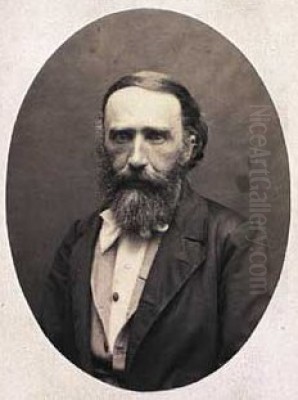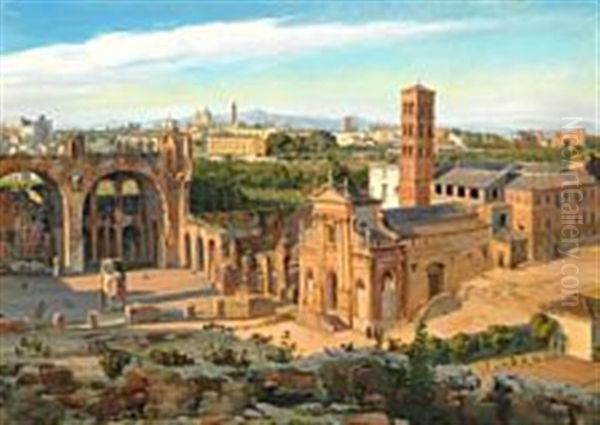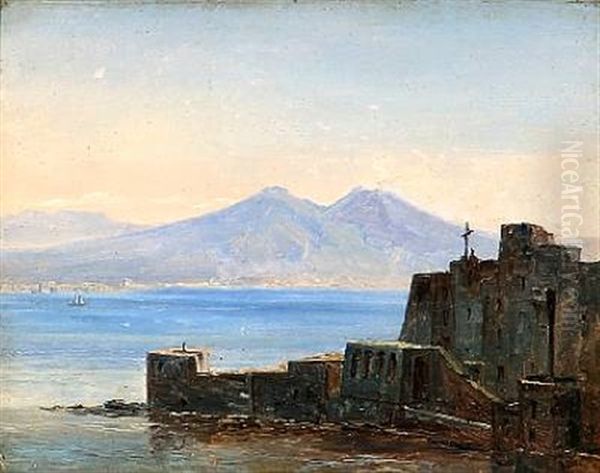
Thorald Laessøe stands as a significant, if sometimes overlooked, figure within the rich tapestry of the Danish Golden Age of painting. Born in Copenhagen on June 25, 1816, and passing away in the same city on March 25, 1878, Laessøe dedicated his artistic career primarily to landscape painting. He became particularly renowned for his evocative depictions of Italian and Greek scenery, capturing the unique light and historical resonance of the Mediterranean world through the lens of his Danish artistic training. His work forms a fascinating bridge between the meticulous observational style fostered in Copenhagen and the long-standing tradition of Northern European artists finding inspiration under the southern sun.
Laessøe emerged during a period of intense artistic flourishing in Denmark. The early 19th century saw Copenhagen, despite political and economic challenges, become a vibrant center for the arts and sciences. Painters sought to forge a distinctively Danish artistic identity, often focusing on local landscapes, portraiture, and scenes of everyday life, rendered with a characteristic clarity, sensitivity to light, and understated realism. Laessøe absorbed these influences but ultimately carved his own path, choosing the landscapes of classical antiquity as his primary subject matter.
His legacy resides in his finely crafted paintings, which offer a window into the landscapes of Italy and Greece as seen through the eyes of a talented Danish observer in the mid-19th century. His works are held in notable collections, ensuring his contribution to the Danish Golden Age, and the broader European landscape tradition, is preserved for future generations.
Early Life and Artistic Formation
Thorald Laessøe's artistic journey began in the heart of Denmark's capital, Copenhagen. Growing up during the Golden Age, he was immersed in an environment where artistic pursuits were gaining unprecedented prominence. His formal training took place at the prestigious Royal Danish Academy of Fine Arts (Det Kongelige Danske Kunstakademi). This institution was the crucible of the Golden Age, shaped significantly by the teachings of Christoffer Wilhelm Eckersberg, often hailed as the "Father of Danish Painting."

While Eckersberg's influence permeated the Academy, emphasizing direct observation from nature, meticulous draughtsmanship, and objective representation, Laessøe also received direct tutelage from another key figure of the era, Christen Købke. Købke, known for his intimate portraits, sensitive landscapes, and remarkable handling of light, undoubtedly left an imprint on the young Laessøe. Some accounts suggest Laessøe was largely self-taught in painting, which might indicate that while he received foundational academic training and guidance from masters like Købke, he developed his specific approach to landscape painting and oil technique through independent study and practice.
This combination of formal instruction and self-directed learning was not uncommon. The Academy provided essential skills in drawing and composition, but artists often honed their individual styles through personal experimentation and careful study of both nature and the works of Old Masters and contemporaries. Laessøe's early work, though less documented, likely reflected the prevailing Golden Age aesthetics before he embarked on the travels that would define his mature style.
The Context of the Danish Golden Age
To fully appreciate Thorald Laessøe's work, it is essential to understand the Danish Golden Age (roughly spanning the first half of the 19th century). This period witnessed an extraordinary output in painting, sculpture, architecture, music, and literature. In painting, the era was largely defined by the legacy of C.W. Eckersberg, who, after studying in Paris with Jacques-Louis David and in Rome, returned to Copenhagen to become a professor at the Academy in 1818.
Eckersberg encouraged his students to paint directly from life, whether it be landscapes, architectural studies, or model studies. This resulted in works characterized by clear compositions, precise details, and a cool, objective rendering of light and atmosphere. Key artists who flourished during this time, alongside Laessøe's teacher Christen Købke, include Constantin Hansen, known for his portraits and large-scale historical and mythological scenes, often inspired by his time in Italy; Wilhelm Marstrand, celebrated for his lively genre scenes and Italian subjects; and Martinus Rørbye, another inveterate traveler whose works documented his journeys through Denmark, Norway, Italy, Greece, and Turkey.
Landscape painting held a special place, with artists seeking to capture the specific character of the Danish countryside. Figures like Johan Thomas Lundbye and Peter Christian Skovgaard became masters of the national landscape, imbuing their scenes with both realism and a sense of romantic nationalism. Laessøe, while trained in this environment, diverged by focusing his mature career almost exclusively on foreign landscapes, bringing the Golden Age techniques of careful observation and light handling to Mediterranean subjects.
The Allure of the South: Travels in Italy and Greece

Like many Northern European artists before and during his time, Thorald Laessøe felt the powerful pull of the South. The classical heritage, the picturesque ruins, the dramatic landscapes, and the quality of the Mediterranean light held an enduring fascination. For artists trained in the often cooler, more diffuse light of the north, Italy offered a different visual world to explore. In 1842, Laessøe embarked on an extensive European journey, a formative experience that would decisively shape his artistic direction.
His travels eventually led him to Italy, where he chose to settle for a significant period, primarily in Rome. Rome, in the mid-19th century, was a vibrant hub for international artists. It was a living museum, where the remnants of antiquity stood side-by-side with Renaissance and Baroque splendors, all set within a lively contemporary city and surrounded by the evocative landscapes of the Roman Campagna. Artists gathered, studied, sketched, and painted, drawing inspiration from the city's rich history and scenic beauty.
Laessøe immersed himself in this environment. He became known as a dedicated painter of landscapes, focusing on well-known sites but rendering them with his characteristic precision and sensitivity. His time in Italy was punctuated by visits to Greece, another land steeped in classical history and offering unique landscapes and architectural wonders. These travels provided him with a wealth of subject matter that would sustain his artistic output for years. Unlike contemporaries such as Lundbye or Skovgaard who found their primary inspiration in Danish nature, Laessøe became an expatriate interpreter of the Mediterranean world.
Artistic Style: Precision and Atmosphere
Thorald Laessøe's artistic style is firmly rooted in the principles of the Danish Golden Age but adapted to his chosen subject matter. His works are characterized by a high degree of realism and meticulous attention to detail. This likely reflects the influence of Eckersberg's emphasis on objective observation and precise draughtsmanship, which was foundational at the Copenhagen Academy. Buildings, ruins, foliage, and geological formations are rendered with careful accuracy.
His compositions are typically well-structured and clear, often employing established landscape conventions but executed with a fresh eye. He possessed a strong ability to capture the specific qualities of light and atmosphere of the Italian and Greek landscapes. While maintaining clarity, his works often convey a sense of place and mood, sometimes incorporating a subtle Romantic sensibility in the choice of picturesque views or the rendering of atmospheric effects, particularly in the skies and distant vistas.
Compared to some of his contemporaries, Laessøe's approach might be seen as less overtly nationalistic or romantic than that of Lundbye, and perhaps less focused on the intimate, everyday scenes sometimes favored by Købke. His focus remained steadfastly on the landscape, often incorporating significant architectural elements. He excelled in the veduta or view painting tradition, but his works often possess a greater naturalism and less idealized quality than earlier proponents of the genre. His paintings stand as careful, thoughtful interpretations of specific locations, rendered with considerable technical skill.
Masterpieces of the Mediterranean
Among Thorald Laessøe's most recognized and celebrated works are his depictions of iconic Roman locations. One particularly notable painting is The Cimitero Acattolico of Rome with the Pyramid of Cestius, completed in 1848. This work captures a view of the Non-Catholic Cemetery (also known as the Protestant Cemetery), a site of great interest to foreign visitors, especially those from Northern Europe, as it was the final resting place for figures like the English poets John Keats and Percy Bysshe Shelley.
In Laessøe's painting, the ancient Pyramid of Cestius, a unique Roman landmark incorporated into the later Aurelian Walls, dominates the background. The cemetery grounds, with their cypress trees and tombstones, occupy the middle ground, rendered with sensitivity and detail. The light suggests a clear Italian day, illuminating the scene with the clarity typical of the Danish Golden Age style. This work, now housed in the Statens Museum for Kunst (SMK - National Gallery of Denmark) in Copenhagen, exemplifies Laessøe's ability to combine topographical accuracy with a subtly evocative atmosphere.
Another significant work from the same year, 1848, is View towards the Roman Forum. This painting offers a perspective on the heart of ancient Rome, depicting the sprawling ruins of temples and basilicas that were increasingly being excavated and studied during the 19th century. Laessøe captures the grandeur of the decaying structures under the Italian sky, again demonstrating his skill in architectural rendering and landscape composition. This particular painting found its way into the collection of the Nationalmuseum in Stockholm, Sweden, gifted from the Danish Royal Collection, indicating the esteem in which his work was held. These paintings represent the core of his achievement: bringing a Danish precision to the celebrated landscapes of the South.
Laessøe in the Company of Artists
Thorald Laessøe's artistic career unfolded within a vibrant network of fellow artists, both Danish and international. His most direct artistic relationship was arguably with his teacher, Christen Købke. While Laessøe developed his own distinct focus on Mediterranean landscapes, the sensitivity to light and careful rendering evident in his work likely owes a debt to Købke's instruction and example.
In Copenhagen, he would have been aware of, and likely interacted with, the leading figures of the Golden Age mentioned earlier: C.W. Eckersberg, Constantin Hansen, Wilhelm Marstrand, Martinus Rørbye, J.Th. Lundbye, and P.C. Skovgaard. While sharing a common artistic foundation, their paths diverged. Laessøe’s choice to specialize in Italian and Greek scenes set him apart from Lundbye and Skovgaard, who became iconic painters of the Danish landscape. His focus on landscape also differentiated him from the figure-centric work of Hansen and Marstrand, though both also spent significant time in Italy and depicted Italian scenes.
During his extended stay in Rome, Laessøe would have encountered artists from across Europe. The city was a magnet for German painters, including figures associated with late Neoclassicism and Romanticism like Joseph Anton Koch and Johann Christian Reinhart, who were renowned for their heroic Italian landscapes. French artists like Camille Corot were also active in Italy, developing a more painterly, atmospheric approach to landscape in their famous oil sketches. British artists, following the tradition of the Grand Tour, were also present; J.M.W. Turner had earlier created dramatic, light-filled visions of Italy, though in a vastly different style. Laessøe's work, with its blend of Northern European precision and Mediterranean subject matter, occupied its own niche within this international milieu. He may also have known the dominant Danish figure in Rome from an earlier generation, the neoclassical sculptor Bertel Thorvaldsen, whose influence was immense.
Later Years and Artistic Legacy
Information about Thorald Laessøe's later life, after his most productive years documented by his Italian and Greek landscapes, is less abundant. It is known that he eventually returned to his native Copenhagen, where he passed away in 1878. He continued to be recognized as a skilled landscape painter, contributing to the rich artistic output of the Danish Golden Age.
His legacy is primarily tied to his specialized contribution as a painter of Mediterranean landscapes within the Danish context. While perhaps not achieving the same level of fame as Eckersberg, Købke, or Lundbye, Laessøe holds a respected place in Danish art history. His works are valued for their technical proficiency, their faithful yet evocative rendering of specific locations, and their representation of the Danish Golden Age engagement with the wider European artistic tradition, particularly the long-standing practice of Nordic artists traveling south for inspiration.
His paintings serve as important documents of 19th-century perceptions of classical lands, capturing famous sites with a clarity and precision characteristic of his training. The presence of his works in major public collections, such as the Statens Museum for Kunst in Copenhagen and the Nationalmuseum in Stockholm, ensures his contribution continues to be accessible. He remains a testament to the diverse paths pursued by artists during Denmark's Golden Age, demonstrating how the principles learned in Copenhagen could be successfully applied to the landscapes of Italy and Greece.
Conclusion: A Northern Eye on Southern Light
Thorald Laessøe represents a fascinating strand within the Danish Golden Age – the artist who, thoroughly trained in the school's emphasis on meticulous observation and natural light, turned his gaze southward. He translated the clear, objective approach fostered by Eckersberg and refined by Købke to the sun-drenched landscapes and ancient ruins of Italy and Greece. His works stand apart from the national romanticism of Lundbye or the intimate domesticity found in some of Købke's pieces, offering instead carefully composed and finely detailed views of classical lands.
His paintings, such as the views of the Cimitero Acattolico and the Roman Forum, are more than just topographical records; they are imbued with the quiet intensity and sensitivity to light that characterize the best of Danish Golden Age painting. They capture the unique atmosphere of these historic places, filtered through a distinctly Northern European sensibility. Laessøe's dedication to his craft and his chosen subject matter resulted in a body of work that earned him respect during his lifetime and secures his position as a notable contributor to 19th-century landscape painting. His art remains a valuable bridge between the artistic culture of Denmark and the enduring allure of the Mediterranean world.